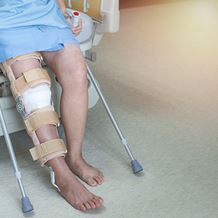Guide to Ergonomic Working: Top tips and know-how, from office to home
- Home
- Services
- Orthopaedics
- Knowledge Hub
- Guide to Ergonomic Working: Top tips and know-how, from office to home
Many of us suffer from aches and pains after a long day, and it’s usually a result of bad posture and a poor work set up. Once upon a time, this was simply accepted as part and parcel of working life. But as we learn more about what individual bodies need to thrive, we have a greater understanding of how to protect our physical health – and avoid problems for the future. Living ergonomically is less about where you are, but more about how you are doing it. Whether it’s at work or at home, in the office or in the kitchen, ergonomic practices are key to improving our physical comfort for the long term.

What is ergonomics and why should you care?
Ergonomics is about designing the environment and workplace in the best possible way to fit the people who use them. There’s nothing worse than suffering from a sore back after sitting at a desk all day, and that’s where ergonomics can help. An ergonomic home office set up applies our knowledge of the human body in a very specific way, improving our interactions with the products and systems we use on a regular basis in order to increase our safety, comfort and performance. Without this, we are at risk of ongoing physical discomfort that may result in musculoskeletal disorders (MSD).
MSDs include any sprains and strains that affect your muscles, nerves, tendons, joints, cartilage, bones and spinal discs. The most common MSD conditions are back pain and osteoarthritis, a common type of arthritis caused by overuse. Both conditions are exacerbated by unsuitable working conditions such as sitting at a desk for long periods. Osteoarthritis can affect any of your joints, and most commonly impacts your hands, wrists, knee, hips and spine.
An ergonomic workspace aims to avoid the common orthopaedic problems associated with seated work which will not only optimise performance, but also improve the quality of work as a result of reduced fatigue, higher engagement and increased morale. And ergonomic living is not just limited to the workspace. It can impact every area of our life, from preparing a meal to watching a movie and weeding the garden. By adopting some simple ergonomic measures and habits, we can banish those aches and pains for good.
Ergonomics at work
An ergonomic workstation is an essential way to avoid those painful symptoms that have a nasty habit of creeping in at the end of long day. Think back pain, neck pain, sore wrists, shoulder aches and more. These common conditions are usually the result of poor posture, repetitive movements, lack of regular movement and inadequate arrangements. In other words: a poor desk setup. Here’s six ergonomic essentials to get your home or work office station exactly where it needs to be to protect your health and wellbeing for the future.
1. Desk setup
Having your desk at the correct height will improve your posture and help you avoid some of the health problems that arise with seated work, such as back pain. You should be able to fit your legs comfortably under your desk with your feet flat to the floor and level with your hips, using a footrest if necessary. You should also have enough room for the angle between your lower and upper arm to rest on your desk between 90-110 degrees (see image) with your wrists sitting flat to the keyboard.
Standing desks are a great way to alleviate posture and circulation issues, and hot desking in the office where possible encourages more movement during the day, as well providing a much-needed change of scenery. Adjustable desks are a smart investment for the home office as they can be configured to suit your specific needs.
Taking regular breaks is also a fantastic way to avoid sitting for extended periods. Aim for 5-10 minutes break out of every hour, and use the time to move away from your desk, get some fresh air or complete some stretching exercises. This will improve circulation, reduce any stiffness and rejuvenate your mind along the way.


2. Monitor placement
With many jobs now computer-based, monitor placement has become increasingly important in terms of maximising comfort and minimising strain. One of the most common misconceptions is that many people think their eyes should be looking directly at the middle of their monitor screen. In fact, the most ergonomic position is actually the top third of the screen. This reduces any pressure on your shoulders and neck by encouraging you to tilt your head very slightly downwards.
Use a specific monitor riser to elevate your screen or improvise with a pile of books until it reaches the correct position. Ideally, it should sit between 50-100cms, or an arm’s length away from you to avoid stressing your eyes and to optmise your comfort. If using a laptop computer, set it up on a raised stand with an external keyboard and mouse for the greatest ergonomic benefits.
3. Supportive chair
Ergonomic chairs are designed to reduce stress on your spine, minimising the opportunity for any strains and sprains. They have adjustable height settings so that your feet sit flat to the floor, with lumbar support that mimics the S-curve of your spine.
If there are any gaps between your spine and the chair, use a rolled-up towel or cushion to give your mid and lower back greater support. This positioning promotes a healthy posture and will minimise fatigue across the day. Adjust the armrests so that your arms can sit comfortably, with your shoulders kept relaxed and down.


4. Keyboard and mouse positioning
The keyboard is best placed directly in front of you and close to the edge of your desk. Your arms and wrists are ideally resting in a neutral position, or angled slightly downwards towards your lap. If your desk is too high to achieve this, consider using a keyboard tray that sits under the desktop, or raise your chair remembering to keep your feet flat to the floor, using a footrest if necessary.
Keep your mouse close by to avoid overreaching. This position reduces pressure on your wrists and avoids conditions such as ‘computer elbow,’ a stress injury that is also known as ‘tennis elbow’. Computer elbow occurs as a result of a repetitive action, such as gripping and squeezing the mouse, causing muscle and tendon pain.
Adapting your desk equipment is the best way to relieve the condition. Ergonomic keyboards are available which are designed to keep your hands shoulder-width apart and in a neutral position, or try using a vertical mouse where the hand rests on its side, avoiding any pressure on the affected tendons.
5. Ample lighting
A well-lit working environment is an essential part of your desk setup as it minimises eye strain and reduces fatigue, as well as relieving any pressure on your neck as you strain to see the screen.
Natural lighting provides the optimal ambience for productivity. As well as serving a practical purpose, it helps reenergises your thoughts and improves your sense of wellbeing. A desk lamp is a great alternative if you are struggling to create enough light.


6. Reduce stress factors
The working day can be stressful, and without even realising it we are sometimes hunched over with our muscles cramped and tense. No matter how ergonomic your workspace is set up, sitting in the same position for long periods of time is not good for your body.
Movement is key to maintaining comfort and posture, reducing stress in the process. Consider ways to improve your working environment such as a Bluetooth speaker to play soft music, a houseplant or some candles. A more relaxed you will lead to greater productivity.
Ergonomics at home
Ergonomic practices don’t just exist in the workplace. Incorporating ergonomic principles into your everyday life will enhance your physical comfort, prevent injury and improve your overall wellbeing. From the kitchen to the loungeroom and everything in between, these tips will ensure you get the most from your living environment.
In the kitchen
- Ensure that your work surfaces are at a comfortable height and sit just below your elbow when standing
- Keep frequently-used items within reach to avoid unnecessary movement
- Consider using kitchen drawers rather than cupboards to protect your back
- Keep regular kitchen items and tools visible to avoid awkward movements
- Alternate the hands used for vigorous motion such as whisking or stirring to avoid repetitive strain
- Use long-handled cleaning tools to avoid back strain
- When cleaning, use a padded cushion to protect your knees
In the bedroom
- Choose a high-quality mattress that supports your body alignment to maximise your sleep quality
- Sleep on your back or side to maintain a neutral spine position
- Use pillows that support the natural curve of your neck
- When reading in bed, prop up your device or book to eye level to avoid straining your neck
- Fix any heavy furniture to the wall to avoid injury
In the loungeroom
- Look for chairs and lounges that provide good lumbar support, and allow your feet to sit flat on the floor
- Keep your TV at eye level to reduce eye
- Leave plenty of space between furniture to allow you to move around safely
Out and about
- Choose hands free devices to avoid neck strain when on the phone
- Protect your back and joints when gardening by using long-handled tools and lifting from your knees and keep your back straight
- Take regular breaks and stay active as this minimises fatigue across the day and improves productivity
By establishing a few healthy habits, you can easily create an ergonomic work and home space that protects your physical and mental wellbeing.
If you’re struggling to recover from injury, or have some niggling joint pains that just won’t go away, talk to our orthopaedic team today.



